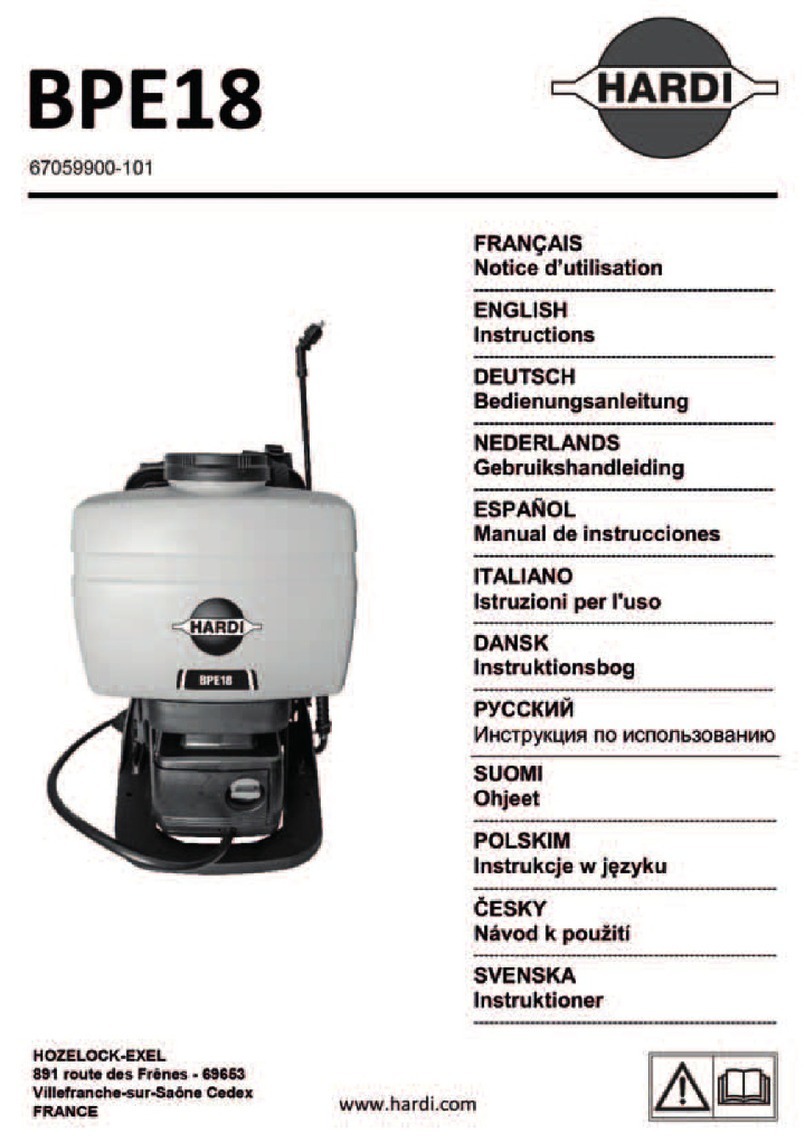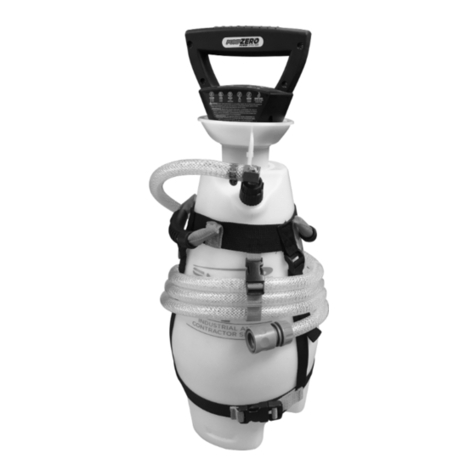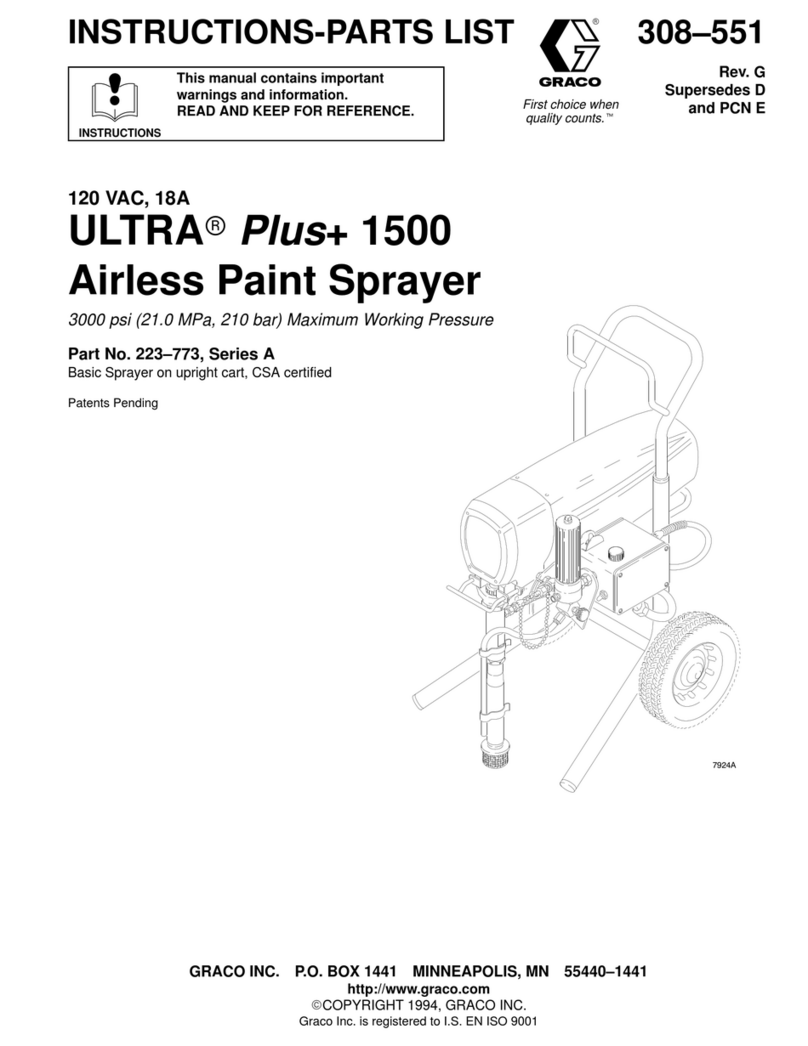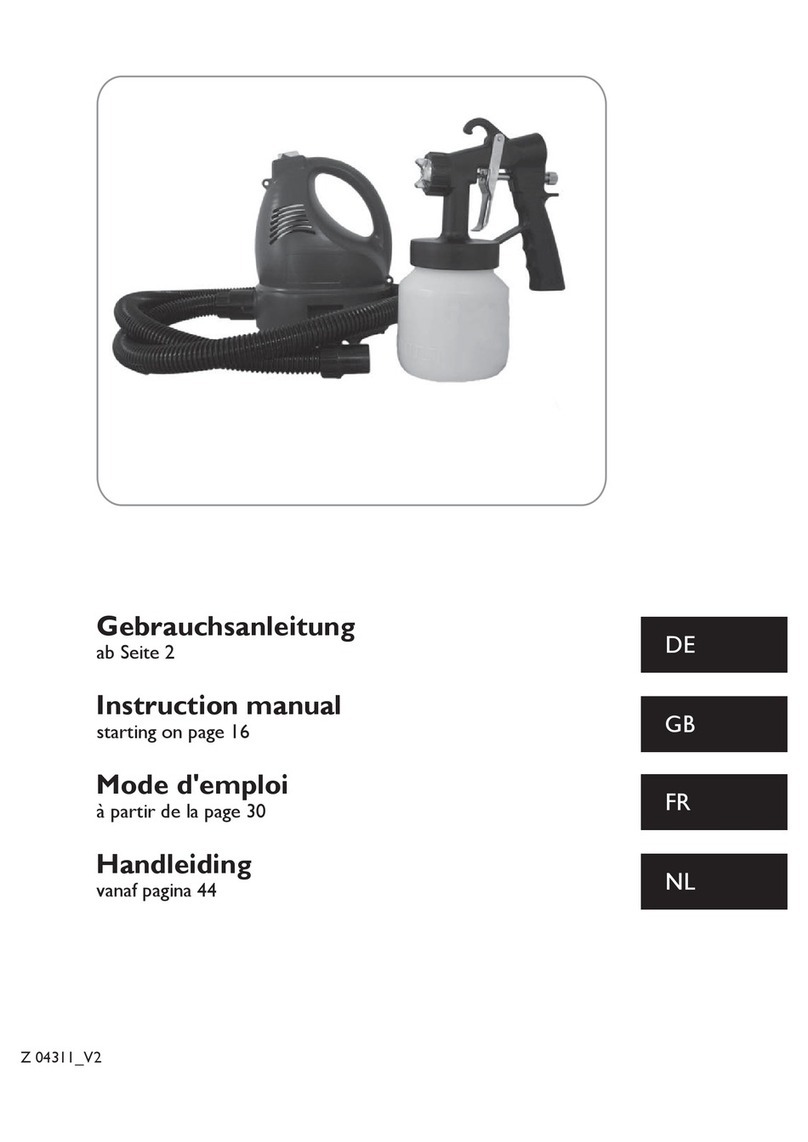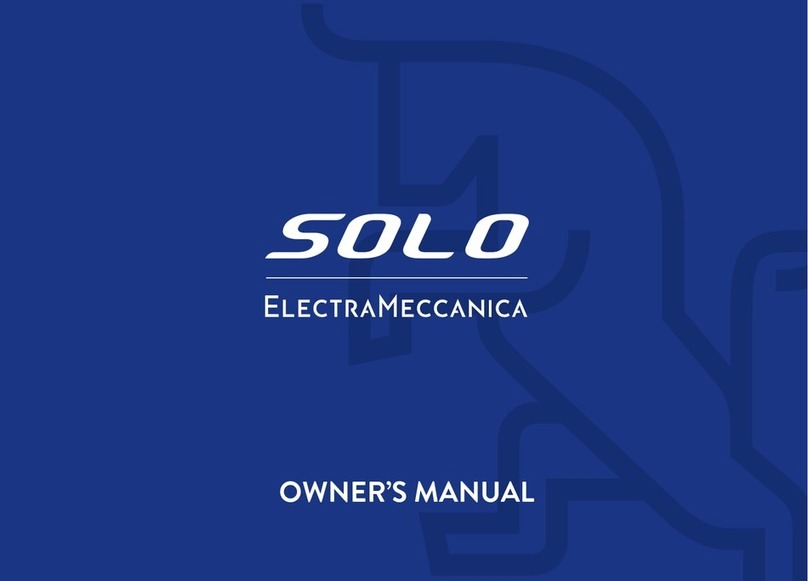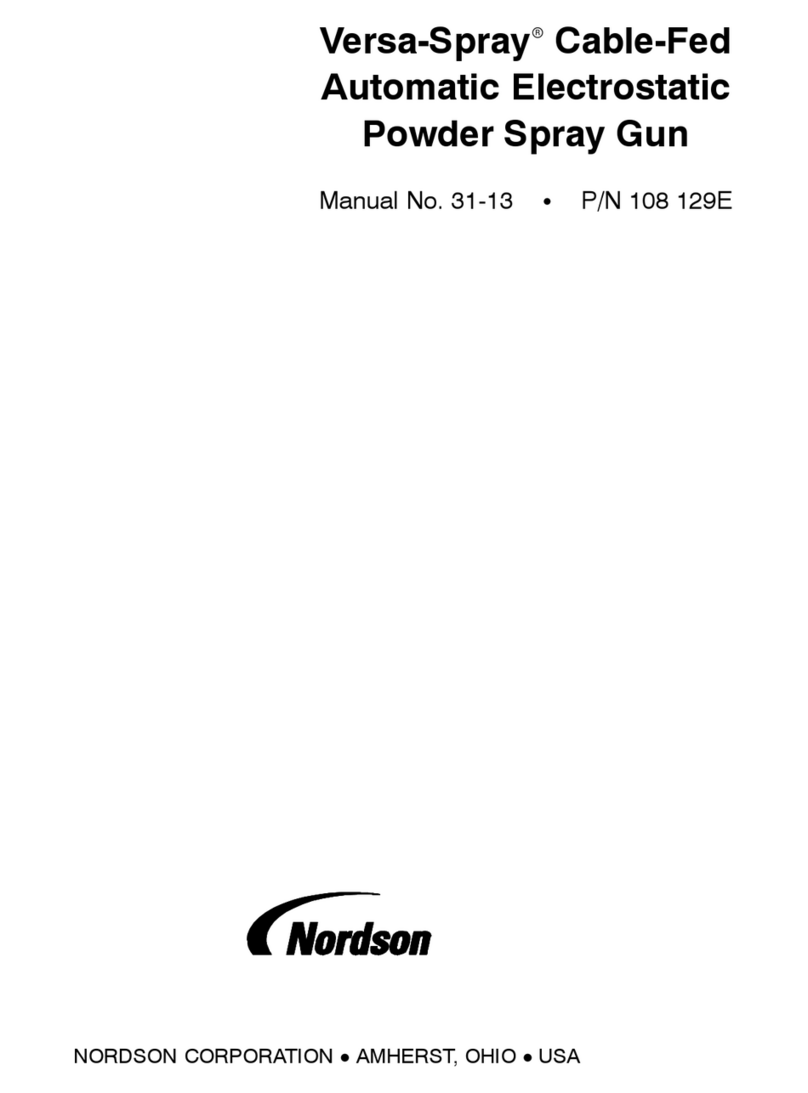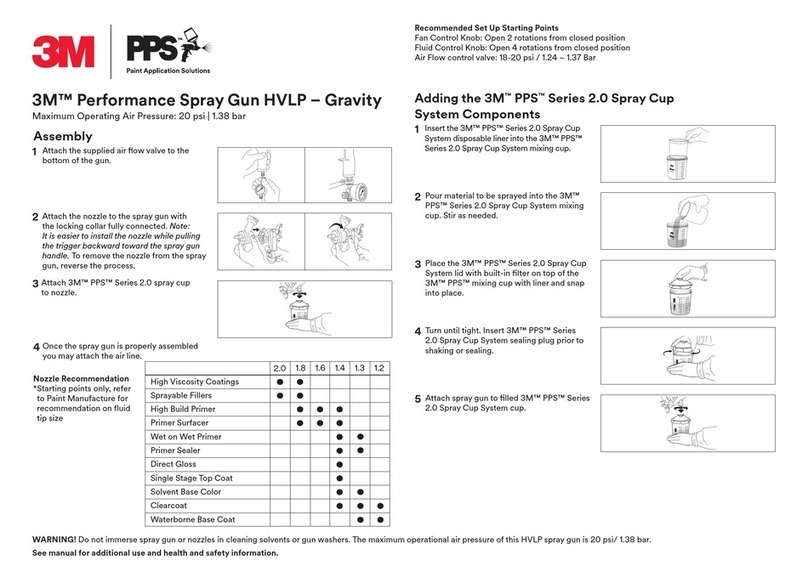Finixa ELITE PRO-33 User manual

1
INSTRUCTION MANUAL
HIGH PEFORMANCE HVLP SPRAY GUN
PRO-33
Important
This manual contains IMPORTANT, WARNINGS and INSTRUCTIONS.
Equipment in this manual is exclusively for painting purpose.
Do not use for other purpose.
The operator shall be fully conversant with the requirements stated in this instruction manual including important warnings, cautions and
operation and correct handling.
Read and understand the instruction manual, before use and retain for reference.
Be sure to observe warnings and cautions in this instruction manual.
If not, it can cause paint ejection and serious bodily injury by drawing organic solvent.
Be sure to observe following
marked items which are especially important.
WARNING
Indicates a potentially hazardous situation which, if not avoided, may result in serious injury or loss of life.
CAUTION
Indicates a potentially hazardous situation which, if not avoided, may result in minor or moderate injury or
property damage.
Important
Indicates notes which we ask you to observe. The safety precautions in this instruction manual are the
minimum necessary conditions.
Following national and local regulations regarding fire prevention, electricity and safety as well as your
own company regulations.
Main Specifications
Model Type of
feed
Atomization
technology
Nozzle
range
mm
Pattern width
mm/inch
Air
consumption
lpm/cfm
*Rec. working
pressure
bar/psi
Max.
Pressure
bar/psi
Max.
Temp.
℃
Mass
g/lbs
PRO-33-
HV
Gravity HVLP φ1.0~2.5 220/8.7(@1.3mm) 320/11.3 2.0/29 6.8/98 5~40 498/1.1
PRO-33-
MP
Gravity MP(LVMP) φ1.0~2.5 260/10.2(@1.3mm) 300/10.6 2.5/36 6.8/98 5~40 498/1.1
*Means air pressure at gun inlet when trigger is pulled and air flows.
Safety precautions
WARNING
1. Spark and open flames are strictly prohibited.
Paints can be highly flammable and can cause fire.
2. Never use the following HALGOGENATED HYDROCARBON SOLVENTS
Which can cause cracks or dissolution on gun body (aluminum) by chemical reaction.
*unsuitable solvents: methyl chloride,dichloromethane,1.2- dichloromethane, carbon
tetrachloride,trichloroethylene,1.1.1- trichloroethane
(Be sure that all fluids and solvents are compatible with gun parts)
3. Securely ground spray gun by using air hose with built-in ground wire.
Ground wire: Less than 1MΩ. Check the earth stability periodically.
If not, insufficient grounding can cause fire and explosion due to static electric sparking.
1. Never point gun toward people or animal.
If done, it can cause inflammation of eyes and skin or bodily injury.
2. Never exceed maximum operating pressure and maximum operating Temperature
3. Be sure to release air and fluid pressures before cleaning, disassembling or servicing
If not, remaining pressure can cause bodily injury due to improper operation or scattering cleaning liquid.
In order to release pressure, first stop supply of compressed air, fluid and thinner to spray gun.
Then remove needle adjust knob and pull fluid needle set toward you.
4. Tip of fluid needle set has a sharp point.
Fire and explosion
Improper use of equipment
Declaration of Conformity available on request

2
Do not touch the tip of fluid needle during maintenance for the protection of human body.
1. Use in a well-ventilated site by using spray both.
If not, poor ventilation can cause organic solvent poisoning and catch fire.
2. Always wear protective gear (safety glasses, mask, gloves)
If not, cleaning liquid, etc., can cause inflammation of eyes and skin.
If you feel something wrong with eyes or skin, immediately see a doctor.
3. Wear earplugs if necessary.
Noise level can exceed 85dB(A), depending on operating conditions and painting site.
4. If operators pull the trigger many times during operation, it may cause carpal tunnel syndrome.
Be sure to take a rest if you feel tired.
1. Never alter this spray gun.
If done, it can cause insufficient performance and failure.
2. Enter working areas of other equipment (robots, reciprocator, etc.) after machines are turned off.
If not, contact with them can cause injury.
3. Never spray foods or chemicals through this gun.
If done, it can cause accident by corrosion of fluid passages or adversely affect health by mixed foreign matter.
4. If something goes wrong, immediately stop operation and find the cause.
Do not use again until you have solved the problem.
How to connect
CAUTION
Use clean air filtered through air dryer and air filter.
If not, dirty air can cause painting failure.
When you use this gun for the first time after purchasing, adjust fluid needle packing set.
Due to this gun’s unique no rubber o-ring design, it is normal that the needle packing may be a little bit overtight or loose after a
period of not using it.
To fix it, please just slowly tighten fluid packing seat and loosen a bit when fluid needle set does not return smoothly, and adjust
so that fluid needle set smoothly moves.
If you use this gun for the first time after purchasing, to remove rust preventive oil inside, it is suggested to manually
clean the fluid passages by spraying thinner and carefully clean air cap, nozzle, spray head and needle with brush and
thinner.
If not, remaining preventive oil can cause painting failure such as fish eyes.
Washing machine may not be able to get the gun cleaned completely.
Firmly fix hose or container to spray gun.
If not, disconnection of hose and drop of container can cause bodily injury.
Use an air hose with minimum 9mm inner diameter.
Depending on hose length, larger I.D. hose may be required.
1. Connect an air hose to air nipple tightly.
2. Connect a fluid hose or a container to fluid nipple tightly.
3. Flush the gun fluid passage with a compatible solvent.
4. Insert the filter into the fluid inlet of gunbody. Make sure the body of the filter is pushed fully so the body of the filter does not protrude from
the cup insert.
5. Attach the Gravity Cup to the fluid inlet, pour paint into container, test spray and adjust fluid output as well as pattern width.
If the finish is too dry, reduce airflow by reducing air inlet pressure. If finish is too wet, reduce fluid flow by turning fluid adjusting knob
clockwise.
If atomization is too coarse, increase inlet air pressure. If too fine, reduce inlet pressure.
How to operate
1. The recommended air inlet pressure is 2bar/29psi for HVLP and 2.5bar/36psi for LVMP (MP). Do not use more pressure than is
necessary to atomise the material being applied. Excess pressure will create additional overspray and reduce transfer efficiency.
2. Recommended paint viscosity differs according to paint property and painting conditions, 18±2 sec./ DIN4 cup is recommendable.
3. Keep fluid output as small as possible to the extent that the job will not be hindered. It will lead to better finishing with the atomization.
4. Set the spray distance from the gun to the work piece within the range of 150-200mm (6-8in).
5. The gun should be held so that it is perpendicular to the surface of the work piece at all times.
Then, the gun should move in a straight and horizontal line. Arcing or tilting may result in uneven
coating.
Protection of human body
Other precautions

3
Maintenance and inspection
WARNING
First release air and pressure fully according to item No.2 of “Improper use of equipment” of WARNING on page 1 to 2.
Tip of fluid needle set has a sharp point. Do not touch the tip of needle valve at the maintenance.
Be careful not to damage the tip of fluid nozzle.
Only an experienced person who is fully conversant with the equipment can do maintence and inspection.
.
CAUTION
Never use commercial or other parts instead of original spare parts.
Never immerse the whole gun into any solvent or cleaning solution such as thinner for over 1 minute.
If not, it may be detrimental to the lubricants, and the seals inside may be out of shape and lead to leakge, even there’s no any
rubber parts used inside the gun, such as o-ring.
When replacing the fluid nozzle or fluid needle, replace both at the same time.
Using worn parts can cause fluid leakage. Also, replace the needle packing at this time.
Torque the fluid nozzle to 18~20Nm (160~180lb.in). Do not over tighten.
To prevent damage to fluid nozzle or fluid needle, be sure to either pull the tirgger and hold while tightening or loosening
the fluid nozzle, or remove fluid adjusting knob to relieve spring pressure against needle collar.
The gravity cup is made from special anti-static materials, but it is still improtant to avoid generating static charges.
The cup must not be claned or rubbed with a dry cloth or paper. It is possible to generate a static charge by rubbing witch, if
discharged to an earthed object could create an incendive spark and cause solvent vapours to ignite.
Only use a dampened cloth or antistatic wipes if manual cleaning is required within a hazardous area.
For routine clean/maintenance, do not dismount any other part than air cap, nozzle and needle from the gun.
If not, the seals & packings inside may face a risk of being out of shape and lead to leakage.
Step-by-step procedure
Important
1. Pour remaining paint out after use. Clean fluid passages and air
cap set. Spray a small amount of thinner to clean fluid passages.
1. Incomplete cleaning can fail pattern shape and uniform
particles. Especially clean fully and promptly two-component
paint after use
2. Clean each section with brush soaked with thinner and wipe out
with waste cloth.
2. Do not immerse the whole in thinner for over 1 minute. If done,
it may damage parts inside, and lubricating may be needed.
3. Before disassembly, fully clean fluid passages.
(1) Disassemble fluid nozzle.
Use spanner to remove fluid nozzle.
(2) Disassemble fluid needle set.
Remove fluid adj. knob and fluid needle spring, and then pull
out fluid needle spring, and then pull out fluid needle from
back of housing.
3. During disassembly, do not scratch housing section.
(1) Remove fluid nozzle aftter removing fluid needle or while
keeping fluid needle pulled, in order to protect in order to
protect housing section.
(2) Be careful when handing tip of fluid needle since it is sharp.
4. Servicing/replacing air valve.
(1) Remove trigger circlip.
(2) Remove trigger pivot, washer and trigger pin.
(3) Remove trigger.
(4) Remove air valve housing assy with hex socket wrench or
spanner.
(5) Remove air valve spring from gunbody.
(6) Remove rear air valve seal from gunbody with a hooked
instrument.
(7) Remove air valve spindle from housing.
(8) Remove air valve packing nut with hex socket wrench or
spanner from housing.
(9) Remove air valve packing with a hooked instrument.
(10) Fit new air valve packing into housing.
(11) Screw air valve packing nut into housing.
(12) Fit new rear air valve seal onto housing.
(13) Insert back air valve spindle into housing
(14) Reassemble spring and air valve housing assy into gunbody.
(15) Reassemble remainning parts in reverse order.
4. Service air valve only when it is not functioning correctly (may
need cleaning) or air leaks.
5. Replacing needle packing.
(1) Remove fluid adjusting knob and spring.
(2) Trigger gun fully and pull out fluid needle.
(3) Remove air cap.
(4) Remove fluid nozzle with spanner.
(5) Remove spray head assy with hex key.
(6) Remove needle packing nut with hex socket wrench.
(7) Remove needle packing nut spring and needle packing.
(8) Remove rear spring washer with a hooked instrument.
(9) Fit new washers, spring,new packing and packing nut in
reverse order and ensure them are engaged.
(10) Reassemble fluid needle, needle spring and fluid adjusting
knob.
(11) Reassemble remaining parts in reverse order.
5. Service needle packing only when it is not functioning correctly
or air leaks.
Too much tightening of fluid needle packing nut can cause bad
movement of fluid needle set and fluid leakage from the tip of
fluid needle.
Where to inspect
Parts replacement
1. Each hole passage of air cap and fluid nozzle.
Replace if it is crushed or deformed.
2. Packing and seals
Replace if it is deformed or worn out.
3. Serious leakage between fluid nozzle and needle.
Replace them both if leakage does not stop after fully cleaning fluid
nozzle and fluid needle.

4
Parts list
# Description Qty # Description Qty # Description Qty # Description Qty
1
Gun body
1
14
Air cap retaining ring
1
27
Trigger
1
40
Needle seat
1
2
Rear spring
washer
115 Air valve spring 128 Trigger pivot 141 Needle spring 1
3
Needle packing
spring
116 Air valve spindle 129 Trigger pin 142 Spring pad 1
4
Front spring
washer
117 Rear air valve seal 130 Trigger baffle 143
Needle /Fluid
adjusting knob
1
5
Needle packing
1
18
Air valve
1
31
Washer
1
44
Fluid inlet
1
6
Packing nut
1
19
Air valve packing
1
32
Circlip 4
1
45
Filter
1
7 Air separater 120 Air valve packing nut 133
Pattern adjusting
valve body
146 Paint cup 1
8 Spray head seal 121 Circlip 5 5 34
Pattern adjusting
valve spindle
147 MPS adapter 1
9 Spray head 122
Air adjusting valve
body
5 35
Pattern adjusting
valve seal
148
Mini Regulator
SGR-45
1
10 Fluid nozzle 123 Air adjusting knob 136
Pattern adjusting
knob
149 Male plug 1
11 Air cap 124
Air adjusting knob
seal
137 Screw 150 Brush 1
12
Slip ring
1
25
1/4” Air inlet
1
38
Housing
1
51
Spanner
1
13
Lock ring
1
26
Trigger pivot washer
1
39
Fluid needle
1
Troubleshooting
Spray pattern
Problems
Remedies
Fluttering
1. Air enters between fluid nozzle and nozzle
seat.
2. Air enters between air baffle and gun body.
3. Air is drawn from fluid needle packing set.
4. Air enters at fluid container fitting nut or fluid
hose joint.
1. Remove fluid nozzle to clean seat. If it is
damaged, replace nozzle.
2. Remove air baffle to clean, if it is damaged,
replace air baffle.
3. Tighten fluid needle packing screw.
4. Tighten joint section after clean.
Crescent
Paint buildup on air cap partially clogs horn
holes. Air pressure from both horns is different.
Remove obstructions from horn holes with attached
brush. But do not use metal objects to clean horn
holes.
Inclined
1. Paint buildup or damage on fluid nozzle
circumference and air cap center.
2. Fluid nozzle is not properly fitted.
1. Clean the paint buildup. If it is damaged, replace
the damaged part.
2. Remove the nozzle and clean it.
Split
1. Paint viscosity too low.
2. Fluid output too high.
1. Add paint to increase viscosity.
2. Tighten needle adjust knob to reduce fluid output.
Or turn pattern adjust valve set clockwise.
Heavy Center
1. Paint viscosity is too high.
2. Fluid output too low.
1. Add thinner to reduce viscosity.
2. Turn needle adjust knob counter-clockwise to
increase fluid output.

5
This manual suits for next models
2
Table of contents
Other Finixa Paint Sprayer manuals
Popular Paint Sprayer manuals by other brands

SATA
SATA top air operating instructions
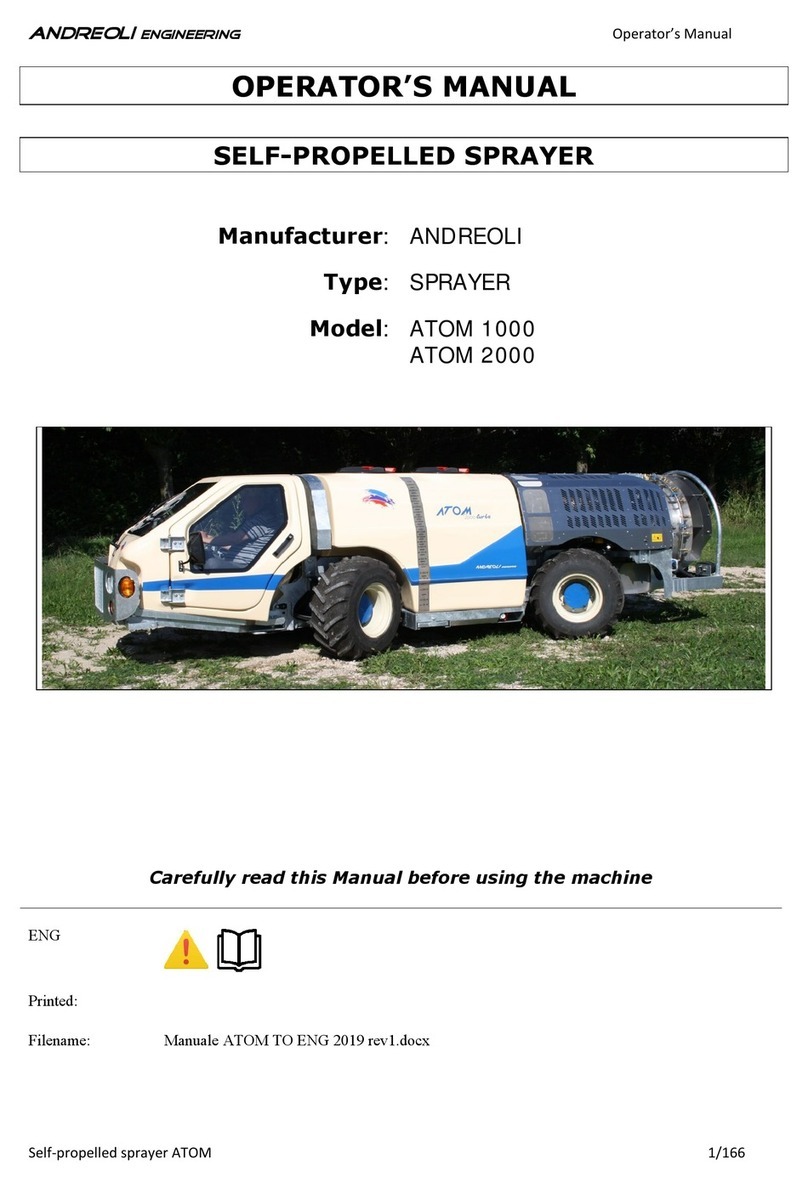
Andreoli Engineering
Andreoli Engineering ATOM 1000 Operator's manual

Craftsman
Craftsman CMXGZBF7124533 instruction manual
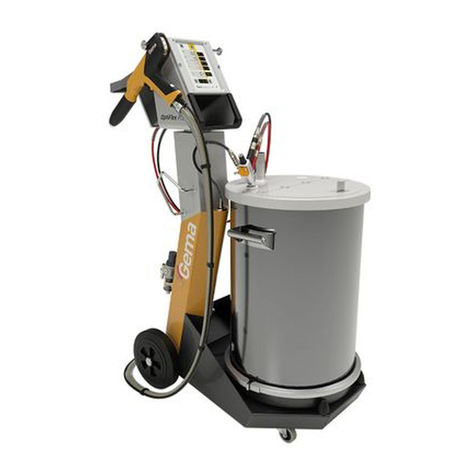
Gema
Gema OptiFlex Pro F Operating instructions and spare parts list

Lauda
Lauda VS 20 OH operating instructions

Graco
Graco SaniSpray HP 20 Operation - repair - parts

